Armenian eternity sign


The Armenian eternity sign (Armenian: հավերժության նշան, haverzhut’yan nshan) or Arevakhach (Armenian: Արևախաչ) is an ancient Armenian national symbol and a symbol of the national identity of the Armenian people.[1] It is one of the most common symbols in Armenian architecture,[2][3] carved on khachkars and on walls of churches.
Evolution and use
In medieval Armenian culture, the eternity sign symbolized the concept of everlasting, celestial life.[4] Since the 5th century, it appeared on Armenian steles, later it becomes part of khachkar symbolism.[5] Around the 8th century the use of the Armenian symbol of eternity had become a long established national iconographical practice,[6] and it keeps its meaning until the modern times.[7] Besides being one of the main components of khachkars,[8] it can be found on church walls,[9][10][11] tomb stones and other architectural monuments.[12][13][14][15][16] Notable churches with the eternity sign include the Mashtots Hayrapet Church of Garni,[17] Horomayr Monastery,[18] Nor Varagavank,[19] Tsitsernavank Monastery.[20] It can also be found on Armenian manuscripts.
The eternity sign is used on the logos of government agencies and on commemorative coins,[21] as well as Armenian government agencies and non-government organizations and institutions in Armenia and the Armenian diaspora.[22]
The symbol is also used by Armenian neopagan organizations and their followers. It is called by them "Arevakhach" (Արևախաչ, "sun cross").[23]
ArmSCII and UNICODE
In ArmSCII, Armenian Standard Code for Information Interchange, an Armenian eternity sign has been encoded in 7-bit and 8-bit standard and ad-hoc encodings since at least 1987. In 2010 the Armenian National Institute of Standards suggested encoding an Armenian Eternity sign in the Unicode character set,[24] and both right-facing and left-facing Armenian eternity signs were included in Unicode version 7.0 when it was released in June 2014.[25]





Gallery
- Churches
.jpg) Saint Hripsime Church, Vagharshapat (7th century)
Saint Hripsime Church, Vagharshapat (7th century) 5-arched eternity sign on the Cathedral of the Holy Mother of God, Harichavank Monastery, near Artik (13th-century)
5-arched eternity sign on the Cathedral of the Holy Mother of God, Harichavank Monastery, near Artik (13th-century)- Makaravank, near Achajur (10th century)
 18 eternity signs on Armenian fresco of the Coptic White Monastery in Egypt, 12th century
18 eternity signs on Armenian fresco of the Coptic White Monastery in Egypt, 12th century Gandzasar monastery, 13th century
Gandzasar monastery, 13th century- Geghard, 13th century
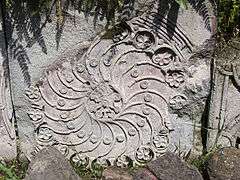 Decor of Teghenyats Monastery
Decor of Teghenyats Monastery Miniature in Gospel by Stepanos, 1201
Miniature in Gospel by Stepanos, 1201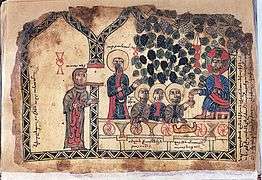 Illuminated manuscript by Hovsian, 1316
Illuminated manuscript by Hovsian, 1316 Grand prince Hasan Jalal Vahtangian, 1214-1261
Grand prince Hasan Jalal Vahtangian, 1214-1261 Aghout cemetery in Sisian
Aghout cemetery in Sisian Saint Mesrop Mashtots Cathedral in Oshakan
Saint Mesrop Mashtots Cathedral in Oshakan
- Modern statues and sculptures
- A khachkar in memory of the victims of the 1988 Spitak earthquake
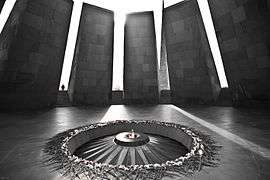 Armenian Genocide memorial in Yerevan, 1965
Armenian Genocide memorial in Yerevan, 1965 A 1992 monument in the Yerevan Cascade dedicated to the adoption of Christianity as state religion in Armenia, known as the "First Christian State"
A 1992 monument in the Yerevan Cascade dedicated to the adoption of Christianity as state religion in Armenia, known as the "First Christian State"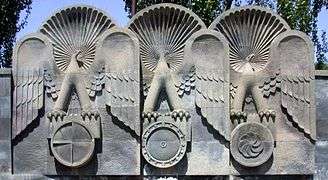 A monument dedicated to the memory of the Armenian soldiers killed in the Nagorno-Karabakh War, Sisian
A monument dedicated to the memory of the Armenian soldiers killed in the Nagorno-Karabakh War, Sisian A monument of Armenian Alphabet and Eternity sign on Oshakan tower
A monument of Armenian Alphabet and Eternity sign on Oshakan tower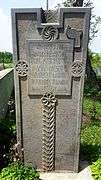 a plaque at the entrance of Hovhannes Tumanyan's museum in Dsegh
a plaque at the entrance of Hovhannes Tumanyan's museum in Dsegh a plaque indicating that the square at the entrance of the Haghpat Monastery was named for Sayat-Nova in 2010
a plaque indicating that the square at the entrance of the Haghpat Monastery was named for Sayat-Nova in 2010
- Logos
 Logo of the Republican Party of Armenia, c. 1990
Logo of the Republican Party of Armenia, c. 1990 Symbol of National Library of Armenia
Symbol of National Library of Armenia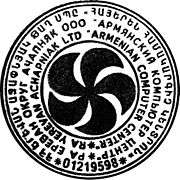 Rubber stamp of the "Armenian Computer Center" Ltd., 1998
Rubber stamp of the "Armenian Computer Center" Ltd., 1998
 Seal of Yerevan, adopted in 2004
Seal of Yerevan, adopted in 2004 The emblem of the Peoples Art Centre in Yerevan
The emblem of the Peoples Art Centre in Yerevan The Japanese national sign Chrysanthemum and the Armenian eternity sign in one logo made in colors of national flags, 2011
The Japanese national sign Chrysanthemum and the Armenian eternity sign in one logo made in colors of national flags, 2011 Water is life - Armenia Fund telethon logo, 2010
Water is life - Armenia Fund telethon logo, 2010
See also
- Petroglyph
- Triskelion
- Swastika
- Borjgali
- Hilarri (Basque steles)
- Picture stones of Gotland
- Pictish stone
- Castro culture (Economy and Arts, Stonework, Metallurgy)
- Khachkar
- List of national symbols
References
- ↑ Armenian Eternity Sign Archived December 3, 2013, at the Wayback Machine., IT Development Support Council of the Government Prime Minister of the Republic of Armenia Archived December 3, 2013, at the Wayback Machine., Workgroup of Language & Culture, 2010 Archived December 3, 2013, at the Wayback Machine..
From page Prehistory of the Armenian Dram and Armenian eternity signs of National institute of Standards of Republic of Armenia. - ↑ Jacob G. Ghazarian (2006), The Mediterranean legacy in early Celtic Christianity: a journey from Armenia to Ireland, Bennett & Bloom, pp. 263, p. 171 "... Quite a different version of the Celtic triskelion, and perhaps the most common pre-Christian symbolism found throughout Armenian cultural tradition, is the round clockwise (occasionally counter-clockwise) whirling sun-like spiral fixed at a centre — the Armenian symbol of eternity."
- ↑ K. B. Mehr, M. Markow, Mormon Missionaries enter Eastern Europe, Brigham Young University Press, 2002, pp. 399, p. 252 "... She viewed a tall building with spires and circular windows along the top of the walls. It was engraved with sun stones, a typical symbol of eternity in ancient Armenian architecture."
- ↑ Bauer-Manndorff, Elisabeth (1981). Armenia: Past and Present. Reich Verlag. p. 89.
The circle, as a line returning upon itself, represented perfection. Having neither beginning, nor end, it was the symbol of eternity. The architects expressed the concept of everlasting, celestial life in the knowledge of the presence and effect of the divine power by sphere.
- ↑ N. Sahakyan/ Armenian Highland: / RAU Press. 2006, page 150(349)
- ↑ Jacob G. Ghazarian (2006), The Mediterranean legacy in early Celtic Christianity: a journey from Armenia to Ireland, Bennett & Bloom, pp. 263, p. 186 "The eighth, or ninth, century date of this two examples of Irish stone crosses places them chronologically well after the carving of stone crosses in Armenia and the use of the Armenian symbol of eternity had become a long established national iconographical practice."
- ↑ Zarian, A. K. (1989). "Խաչքարերի խորհրդանշաններին և միթրայականությանը վերաբերող պատկերագրական հարցեր [Iconographical Problems Concerning Symbols of Khatchkars and Cult of Mithra]". Patma-Banasirakan Handes (in Armenian). Yerevan: Armenian National Academy of Sciences (1): 202–219. ISSN 0135-0536.
- ↑ The government of Armenia, The list of non-material cultural heritage of Armenia, 2010, p. 15
- ↑ R. Kartashyan, «Architectural complex of Khoranashat», The journal of social sciences №4, Yerevan, 1986, pp. 42—52
- ↑ Hayden Herrera (2005), Arshile Gorky: His Life and Work, Macmillan, pp. 784
- ↑ Károly Gink, Károly Gombos, Armenia: landscape and architecture, Corvina Press, 1974
- ↑ Nicolas Holding (2011), Armenia, Bradt Travel Guides, pp 312, p. 130, 148
- ↑ G. Sargsyan, U. Melkonyan, Litographical sketches - 2, Historico-phylological journal of Armenian Academy of sciences, № 3, 2012, p. 101
- ↑ R. L. Khachatryan, Russian academy of Art, Rudolg Khachatryan: high-dimensional objects, Galart, 2002, p. 13
- ↑ Armenia Today, vol. 5-6, Yerevan, 1982, p. 4
- ↑ G. Karakhanyan, «Medieval domesstic reliefs of Armenia», The journal of social sciences, №8, Yerevan, 1975, pp. 31—47
- ↑ see image of the dome
- ↑ Manoucharian, A. A. (1979). "The Upper Complex of the Horomayr Monument". Patma-Banasirakan Handes (in Armenian). Yerevan: Armenian National Academy of Sciences (4): 268.
Երկու զարդեր են քանդակված կամարների ներսի կողմի վերնամասում։ Մեկը պատկերում Է հավերժության նշան, կազմված գնդաձև ուռուցիկ մակերեսին սփռված ելունդավոր գծերով։
- ↑ Kartashian, Hrach. "The architectural ensemble of Nor Varagavank". Patma-Banasirakan Handes (in Armenian). Yerevan: Armenian National Academy of Sciences (7): 65. ISSN 0320-8117.
Պսակ-գոտու անմիջապես վերևով անցնում է եզան և կտցահարող թռչունների, նռնենու տեսքով կենաց ծառի, զամբյուղների, վարդյակի և հավերժության նշանի պատկերներով քանդակաշարք, որն ունի գաղափարական որոշակի իմաստ:
- ↑ Asratyan M., Tsitsernavank, Historico-phylological journal of Armenian Academy of sciences, № 2, 1980, p. 50
- ↑
- "Մամլո հաղորդագրություն - "Շուշիի ազատագրման 20-ամյակ" (ոսկի) [News release - A golden coin dedicated o the 20th anniversary of the Liberation of Shushi]" (PDF). Central Bank of Armenia. 24 January 2012. Retrieved 4 October 2013. see the image of the coin
- "Հայաստանի Հանրապետության Կառավարության 2002 Թվականի Հունվարի 7-ի N 6 Որոշման Մեջ Փոփոխություններ Կատարելու Մասին". Armenian Legal Information System. 18 April 2012. Retrieved 4 October 2013., see the logo of the Customs Service of the Republic of Armenia
- The Council of the city Yerevan, the seal of Yerevan, 2010, see the logo of Yerevan
- Ministry of Justice of RA, about the medals and decorations, 2007
- The government of Armenia, symbol of the cooperation «Armenia-Diaspora», 2012
- Ministry of Emergency Situations, about the medals and decorations, 2011, see the symbol of the cooperation «Armenia-Diaspora»
- Central Bank of Armenia, coin «15-years of liberation of Shushi», 2007, see the image of the coin
- ↑ National Council of Western Armenia, the flag of Western Armenia, 2011
- ↑ Հայկական արիական հիմնական նշանների (սիմվոլների) խորհուրդը եւ չափային շղթաները (in Armenian). Armenian Aryan Union. Retrieved 4 October 2013.
- ↑ "Armenian Eternity Sign" (PDF). Unicode. 2010. pp. 10–12.
- ↑ "Unicode: Armenian" (PDF). Retrieved 2014-06-27.
External links
 Media related to Armenian Eternity sign at Wikimedia Commons
Media related to Armenian Eternity sign at Wikimedia Commons- Hayastan All Armenian Fund. Telethon 2010 - Water is Life. "Water is Life indeed and as you can see in the design, the water turns into the Armenian eternity symbol as it flows out of the helping hands."
- Downtown, North End. "Armenian Heritage Park to participate Saturday in World Labyrinth Day", Posted by Jeremy C. Fox April 29, 2013. - "A single jet of water and the symbol of eternity mark its center, representing hope and rebirth."
- Armenian Engineers & Scientists of America. "The Armenian Engineers and Scientists of America (AESA) logo is an ancient symbol used in Armenian architecture and carvings. The symbol signifies Eternal Life - in Armenian Haverjoutian Nshan or Sign of Eternity."
- Armenian Monuments Awareness Project